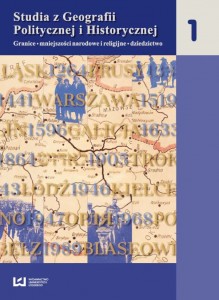Granice na Bliskim Wschodzie – przeszłość, teraźniejszość, przyszłość
DOI:
https://doi.org/10.18778/2300-0562.01.04Słowa kluczowe:
Bliski Wschód, granice międzynarodoweAbstrakt
Międzynarodowe granice na Bliskim Wschodzie ustalone zostały w XX w. za sprawą państw europejskich, wśród których prym wiodła Wielka Brytania. Przy wytyczaniu granic zostały uwzględnione więc przede wszystkim interesy kolonialne europejskich imperiów, natomiast pod uwagę nie wzięto w stopniu należytym pragnień i aspiracji żyjących na tym obszarze ludów. W zależności od lokalizacji, granice bliskowschodnie można podzielić na następujące: naturalne, biegnące wzdłuż dawnych granic administracyjnych Imperium Osmańskiego, oraz sztuczne, przybierające charakter linii prostych i nierespektujące uwarunkowań etnicznych.
Bliski Wschód jest tym regionem świata, gdzie najpóźniej ustanowiono nowoczesne granice liniowe. Z tego powodu występują tam nadal spory w kwestii delimitacji tych granic. Szczególnie poważnym przypadkiem są granice Izraela. Tylko jedna z jego granic – z Egiptem – jest uzgodniona poprzez umowę międzynarodową, poza tym tylko dwa fragmenty granicy z Jordanią nie są kwestionowane. Toczone od pewnego czasu syryjsko-izraelskie rozmowy pokojowe, jak również rokowania pomiędzy Izraelem a Autonomią Palestyńską, zostały zawieszone właśnie z powodu niemożliwości rozwiązania sporów granicznych. Autonomia Palestyńska nadal liczy na międzynarodowe uznanie jej granic, co stworzyłoby nowy układ geopolityczny na Bliskim Wschodzie.
Bibliografia
Agreement between His Majesty’s Government and the French Government respecting the Boundary between Syria and Palestine from the Mediterranean to El-Hama, 1910, London.
Google Scholar
Amadouny V.M., 1995, The formation of the Transjordan – Syria Boundary, „Middle Eastern Studies”, 31 (3).
Google Scholar
DOI: https://doi.org/10.1080/00263209508701068
Biger G., 1984, Geographical and political issues in the delimitation of the northern boundary of Palestine during the Mandate Period, [in:] Shmueli A. et al. (eds.) The Book of Galilee, Haifa.
Google Scholar
Biger G., 1994, An Empire in the Holy Land, New York.
Google Scholar
Biger G., 1995, The Encyclopedia of International Boundaries, New York.
Google Scholar
Blake G.H. and Drysdale A., 1985, The Middle East and North Africa: A Political Geography, Oxford.
Google Scholar
Blake G.H. and Schofield R.N. (eds.), 1987, Boundaries and state Territory in the Middle East and North Africa, Cambridge.
Google Scholar
Brawer M., 1988, Israel’s Boundaries – Past, Present and Future, Tel-Aviv.
Google Scholar
Cumming H.H., 1938, Franco-British Rivalry in the Post-War Near East, London.
Google Scholar
Curzon N., 1907, Frontiers, Oxford.
Google Scholar
Hourani A.H., 1946, Syria and Lebanon: a Political Essay, London.
Google Scholar
Israeli-Jordanian General Armistice Agreement (3 April 1949), 1983, [in:] Rosental Y. (ed.), Documents on the Foreign Policy of Israel, vol. 3, Jerusalem.
Google Scholar
Kliot N., 1987, The Development of the Egyptian-Israeli Boundaries 1906–1986, [in:] Blake G.H. and Schofield R.N. (eds.), Boundaries and State Territory in the Middle East and North Africa, Cambridgeshire.
Google Scholar
Monroe E., 1963, Britain’s Moment in the Middle East 1914–1956, London.
Google Scholar
Newman, D., 1995, Boundaries in Flux: The „Green Line” boundary between Israel and the West Bank – Past, Present and Future, „Boundary and Territory Briefing”, 1 (7).
Google Scholar
DOI: https://doi.org/10.1163/221161497X00179
Prescott J.R.V., 1965, The Geography of Frontiers and Boundaries, London.
Google Scholar
Schofield C. and Schofield R. (eds.), 1994, The Middle East and North Africa – World Boundaries Series, vol. 2, London.
Google Scholar
Wenmer M.W., 1991, The Yemen Arab Republic: Development and Change in an Ancient Land, Boulder.
Google Scholar
Pobrania
Opublikowane
Jak cytować
Numer
Dział
Licencja

Utwór dostępny jest na licencji Creative Commons Uznanie autorstwa – Użycie niekomercyjne – Bez utworów zależnych 4.0 Międzynarodowe.








